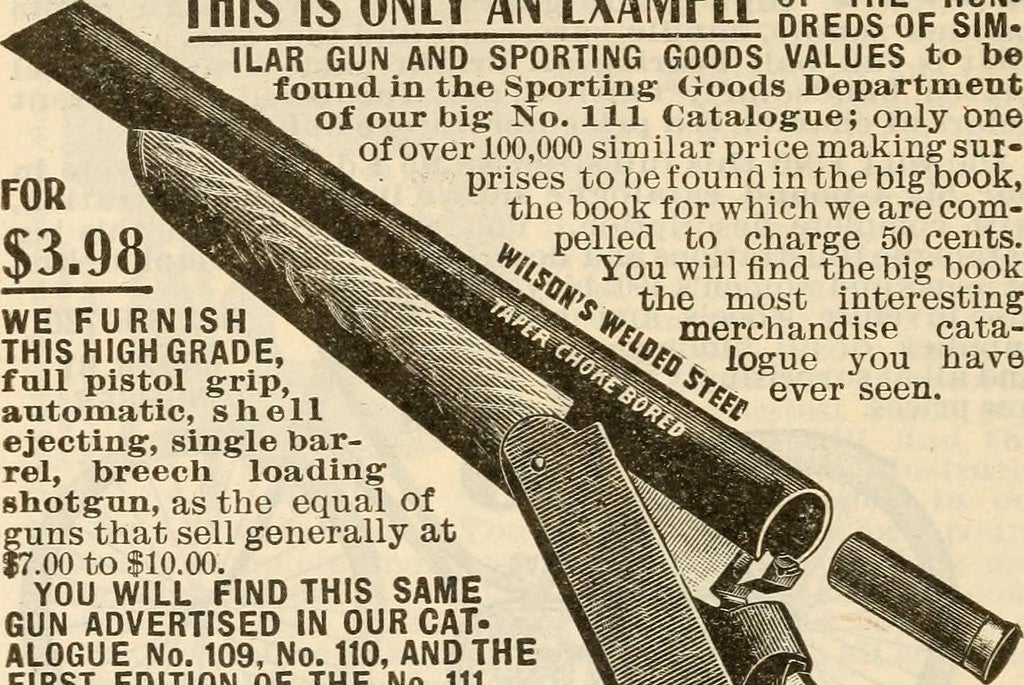Gun Control Lesson From an Old Sears Catalog
Russ Chastain 04.08.19

I recently came across an article by Jeff Minick, which uses the old Sears Roebuck catalog to make a great point about guns and gun violence: Easy, unregulated availability of guns does NOT result in more violence. In 1897, anyone could order a revolver and it would be delivered to them, no questions asked. Mayhem must have ruled the day, hmm?
[I]n the Sporting Goods Department we find 28 pages of guns, ammunition, and accessories.
Here we have weapons ranging from the Daisy Air Rifle to ‘Our $1.55 Revolver,’ from shotguns for $7.95 to Marlin Repeating Rifles. Sears, Roebuck & Company also sold ammunition, pistol holders, reloading tools, and cleaners for these weapons.
No one was monitoring these sales. The government had no part in regulation. No one conducted background checks on the buyers. Indeed, Sears brags that it is ‘the headquarter for everything in guns,’ that their prices are below all others, and that ‘we will send any revolver to any address.’
Yikes, right? Even a common laborer, for three or four days wages, could order a Saturday night special from Sears. With guns and ammo so easily available, we might guess that the streets of every American city and town were running red with blood every day of the week. Mass murder surely occurred on a weekly basis. Assassination and terrorist attacks must have happened so regularly that no one blinked an eye.
We might guess so, but we would be wrong.
Minick continues by examining the actual numbers of murders and “non-negligent homicides” (with or without firearms) in the United States:
1900: 1 per 100,000
1980: 11 per 100,000
Now: 4-1/2 per 100,000
Hmmm. With guns so easily available and entirely unregulated, why was the USA 4 to 5 times safer 120 years ago?
First, our recent ancestors had more respect than we do for human life. People living in 1900 died from diseases and ailments now vanquished. They were more familiar with death than most of us living today. Relatives often died at home rather than in a hospital. In a time of high infant mortality and death due to diseases now casually treated with antibiotics, perhaps each life was regarded as special.
In addition, the men and women of 1900 were not drenched in today’s artificial violence. According to some studies, the average young person will see 200,000 acts of violence in movies and on television by the age of 18. Furthermore, numerous studies show that playing violent video games lead to aggressiveness, especially in young men. Were Mortal Kombat, Postal, and Mad World available to sixteen-year-old Johnny in 1900, perhaps he too would have been more prone to take to the streets with his father’s revolver.
The breakdown of the family, accompanied by the erosion of religious faith and moral teaching in schools and the public square, has surely contributed as well to the increase in gun violence and the murder rate. Young men growing up fatherless, the belief that we can create our own moral code, the move away from the Commandments, including the one enjoining us not to kill, may all contribute to our higher murder rates.
In other words: we have more murder due to moral decay. And I will add that moral decay, which results in an increasingly-violent world, makes an excellent reason to REMOVE all existing restrictions on guns and gun ownership, so the populace may better protect itself from ever-greater numbers of lawless and violent miscreants.
Mr. Minick maintains:
Instead of pointing at firearms as the cause of violence, maybe we should ask: “What sort of people have we become? What part of our humanity have we lost in the past six-score years?”
To steal a construct from Shakespeare: Perhaps the fault lies not in our guns, but in ourselves.
I find it hard to argue with that.